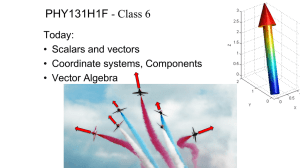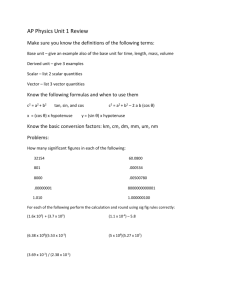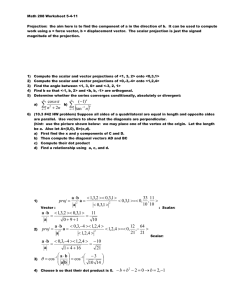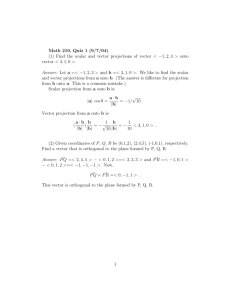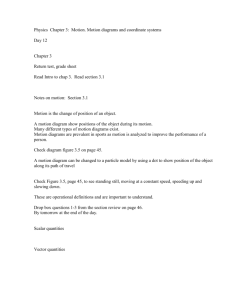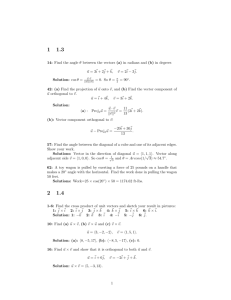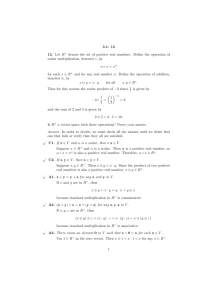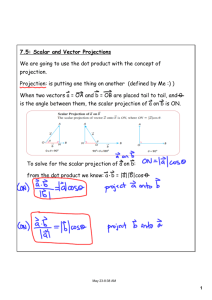PPTX
advertisement
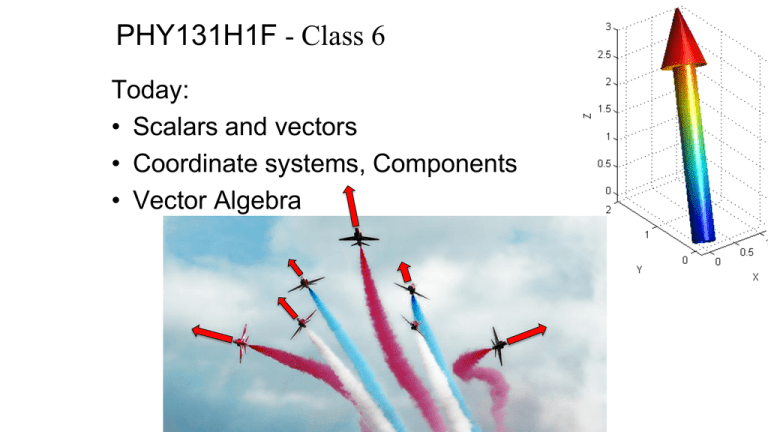
PHY131H1F - Class 6 Today: • Scalars and vectors • Coordinate systems, Components • Vector Algebra Clicker Question The ball rolls up the ramp, then back down. Which is the correct acceleration graph? [Define positive s as up and to the right, parallel to the ramp..] Last day I asked at the end of class: • Can you add a scalar to a vector? • ANSWER: No. A 2-D vector is represented by a pair of numbers (ie x- and y- components, or magnitude and direction), and you can’t add a scalar number to this. • Can you multiply a vector by a scalar? • ANSWER: YES! When you multiply a vector by a scalar, you can either: – Multiply both the x and y components by this scalar, or – Multiply the magnitude by the scalar, and keep the direction unchanged (but you flip direction 180° for a negative scalar) Right Triangle Trigonometry • This is one of the most common things people are rusty with. sin 𝜃 = opp hyp cos 𝜃 = adj hyp tan 𝜃 = opp adj Hypotenuse SOH CAH TOA Opposite Adjacent Clicker Question: • If the hypotenuse below is 6m and the angle is 38, what is the length of the adjacent side? Hypotenuse Opposite A. 6 m sin(38°) B. 6 m tan(38°) C. 6 m cos(52°) D. 6 m cos(38°) E. Not enough information Adjacent Clicker Question: • If the adjacent side below is 6 m and the opposite side is 4 m, what is the angle ? Hypotenuse Opposite A. B. C. D. E. tan−1 (6/4) cos −1 (6/4) cos −1 (4/6) tan−1 (4/6) sin−1 (4/6) Adjacent Vectors • There are two kinds of Physical quantities we will deal with: – Scalar (Only has a size) • Quantity that can be described with only one number. • Examples: time, speed (just a magnitude say 5 miles per hour) – Vector: (Has size and a direction) • Quantity that is described with two numbers: – Magnitude – Direction • Examples: Position, velocity (magnitude say “5 m/s” and direction say “north”) Distance vs Displacement Example • From High Park, you ride your bike 4 miles East on Bloor St, then 3 miles North on Yonge St to the corner of Yonge and Eglinton. a. What is the distance traveled? b. What is your displacement? Clicker Question: Which figure shows A1 A2 A3? http://phet.colorado.edu/en/simulation/vector-addition Announcements • The first term test will be on Tuesday, Sep 30, from 6:00pm to 7:30pm. • Test 1 will cover chapters 1-3 plus the Error Analysis Mini-Document, plus what was done in Practicals • You must bring a calculator and one 8.5x11’ aid sheet which you prepare, double-sided • If you have a conflict at that time with an academic activity (test, lecture, tutorial, lab), you must register to write at the alternate sitting of this test by going to portal and filling out the online form no later than Sep. 25 by 4:00pm. Components add and subtract like scalars! Vector Addition By Components • 𝐴1 = 1.41 m, up and to the right, 45.0° above the horizontal. • 𝐴2 = 1.41 m, down and to the right, 45.0° below the horizontal. • 𝐴3 = 2.24 m, down and to the left, 26.6° below the horizontal. • Find the sum 𝐴1 + 𝐴2 + 𝐴3 . Vector Addition By Components (Let’s tilt the axes!) • 𝐴1 = 1.41 m, up and to the right, 45.0° above the horizontal. • 𝐴2 = 1.41 m, down and to the right, 45.0° below the horizontal. • 𝐴3 = 2.24 m, down and to the left, 26.6° below the horizontal. • Find the sum 𝐴1 + 𝐴2 + 𝐴3 . Clicker Question: Which figure shows 2 A − B ? Clicker Question: The sum 𝐹1 + 𝐹2 + 𝐹3 points to the left. Two of three forces are shown. Which is the missing third force? A. B. C. D. Example from a previous PHY131 Mid-Term Test A ball is suspended on a string, and moves in a horizontal circle as shown in the figure. The string makes a constant angle θ = 10.0° with the vertical. The tension in the string is 8.46 N, and the force of gravity on the ball is 8.33 N, in the negative-y direction. What is the sum of these two forces on the ball? Clicker Question: • 𝐴 = −3𝑖 + 3𝑗 • 𝐵 = 3𝑖 + 4𝑗 • What is the sum 𝐴 + 𝐵? A. B. C. D. E. 3𝑗 7𝑖 + 7𝑗 −3𝑖 + 7𝑗 7𝑗 −3𝑖 − 3𝑗 Before Class 7 on Monday • Please read Chapter 4, sections 4.1 through 4.4 • Problem Set 2 is due Sunday by 11:59pm • Pre-class Quiz for Class 7 is due Monday morning by 8:00am. • Something to think about: One bullet is fired horizontally at a very high speed. The other bullet is initially at rest, but is dropped at the exact same moment the first bullet is fired. Which bullet hits the ground first?
